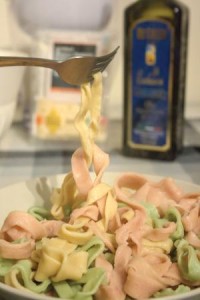If the complexities of polymer physics elude you, the scientists from the University of Warwick may have a way to more clearly explain this premise.
Davide Michieletto and Matthew S. Turner have taken to the kitchen in an effort to more clearly explain polymer complexities. In order to do this, the two physicists have created a new type of pasta called the “anelloni.”
The “annoloni” – which is the Italian word for “ring” – works as a sort of analogy to explain the complicated shapes that ring-shaped polymers can adopt.
This from Institute of Physics:
With just two eggs and 200 g of plain flour, Michieletto and Turner have created large loops of pasta that, when cooked and thrown together in a bowl, get hugely tangled up, in much the same way that ring-shaped polymers become massively intertwined with each other.
But if words are not enough, check out the video below.
Want to learn more about polymers? Check out the article “Conducting Polymers and Their Electrochemistry” in the ECS Electrochemistry Knowledge Base.
And check out the latest peer-reviewed polymer research in our Digital Library!



